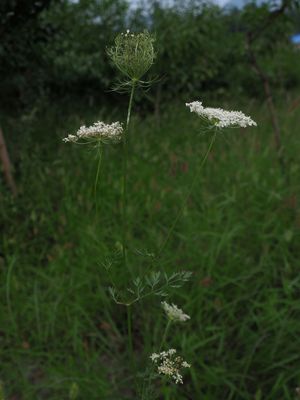Geography and distribution
Wild carrot is thought to have originated on the Iranian Plateau (an area which now includes Afghanistan, Pakistan and Iran). It now grows across much of western Asia and Europe.
It occurs in free-draining and slightly acidic soils on rough grassland, coastal cliffs and dunes. It frequently naturalises in fields and gardens.
Description
Overview: A biennial (flowers produced after the second year of growth) up to 150 cm tall with a grooved, hairless or bristly stem.
Leaves: Finely divided, giving a feathery appearance. Upper leaves are reduced and have a sheathing petiole (leaf stalk). Leaves have a characteristic carrot odour.
Roots: Small (in comparison to commercial carrots), tough, pale-fleshed taproot.
Flowers: White to purple-tinged, borne in late summer in umbrella-like clusters (umbels) up to 7 cm in diameter, with many bracts underneath. The umbels can be concave, flat or convex. Central flowers of the umbel are sometimes dark purple.
Flowering heads become concave (and are considered to resemble birds' nests) when they turn to seed.
Fruits: Dry schizocarp (splitting into two single-seeded portions), 2-4 mm in diameter, with spiny ridges. The spiny fruits attach to the fur of passing animals, aiding seed dispersal.
Purple, white and yellow - colourful carrot history
It is thought that the familiar orange carrot in cultivation today originated in the area around Afghanistan, Iran and Pakistan and had roots that were dark purple due to the presence of the pigment anthocyanin. Dark red and purple carrots are still grown in Afghanistan today.
Wild carrot was taken westwards from this region to Asia Minor (in the 10th or 11th century), Spain (12th century) and northwestern Europe (by the 15th century), and eastwards to China (in the 13th or 14th century) and Japan (by the 17th century). Some mutant yellow and white forms, devoid of anthocyanin, occurred at some stage.
Evidence from documents and paintings (including Christ and the Adulterers by Pieter Aertsen, 1559) suggests that carrots cultivated in northwestern Europe up to the 16th century were all purple or yellow and long. The yellow forms were usually preferred as the pigment from purple forms stained soups and sauces.
Selective breeding of yellow carrots in the Netherlands in the 17th century gave rise to carrots with a higher concentration of orange pigment (beta-carotene). Following this, further cultivars were produced giving rise to the immense variety of root shapes, sizes and colours available today.
Carrots in Babylon?
Wild carrot appears in a list of plants grown in the royal garden of Babylon in the 8th century BC. It was included in the list of aromatic herbs (rather than that of vegetables), so it is thought to have been grown for its fragrant leaves or seeds.
Uses Wild carrot
Wild carrot is sometimes cultivated as an ornamental, being particularly useful for meadow areas of wildlife gardens. It is a food plant for the caterpillars of swallowtail butterflies (such as Papilio machaon and P. polyxenes ) and a source of pollen and nectar for bees. Wild carrot reproduces by seed and can be prolific, so should be prevented from going to seed in a garden situation.
Flower heads are attractive in fresh or dry flower arrangements, and the bird nest-like seed heads are also useful for dry arrangements.
Daucus carota subspecies sativus
Daucus carota subspecies sativus is cultivated as an annual across much of the temperate and tropical world for its edible, orange storage roots. Carrot is a major root vegetable for human consumption, and also an important fodder crop, with world production of over 20 million megatons.
Carrots are eaten raw in salads; cooked in soups, stir-fries, and casseroles; served alone as a side vegetable; and processed to make baby foods. Carrot is frequently used as a colourful garnish, often grated, sometimes sculpted into decorative flower-like shapes.
Carrot juice is popular as a healthy drink, both alone or mixed with other vegetable and fruit juices. Carrots are used in sweet dishes such as carrot cake and in Asia often used in jams and syrups.
Carrots are a source of the natural food dye carotene. Carrot fruit oil has been used for flavouring liqueurs and as an ingredient in cosmetics.
Millennium Seed Bank: Seed storage
The Millennium Seed Bank Partnership aims to save plant life worldwide, focusing on plants under threat and those of most use in the future. Seeds are dried, packaged and stored at a sub-zero temperature in our seed bank vault.
More than 80 collections of Daucus carota seeds are held in Kew's Millennium Seed Bank based at Wakehurst in West Sussex.
This species at Kew
Daucus carota can usually be seen growing in the Plant Family Beds and Student Vegetable Plots at Kew.
Pressed and dried specimens of Daucus carota are held in Kew's Herbarium where they are available to researchers by appointment. The details of some of these specimens, including images, can be seen online in Kew's Herbarium Catalogue.
online
Specimens of seeds, roots and seed oil of wild carrot are held in Kew's Economic Botany Collection, where they are available to researchers by appointment.


















